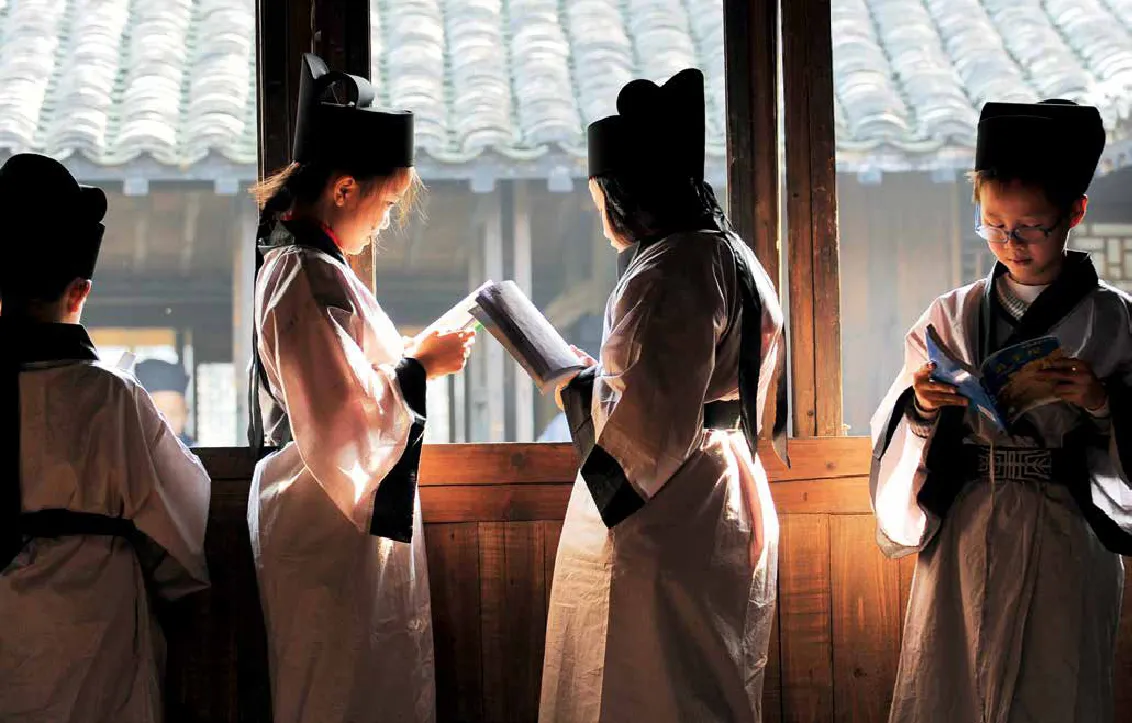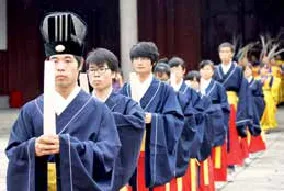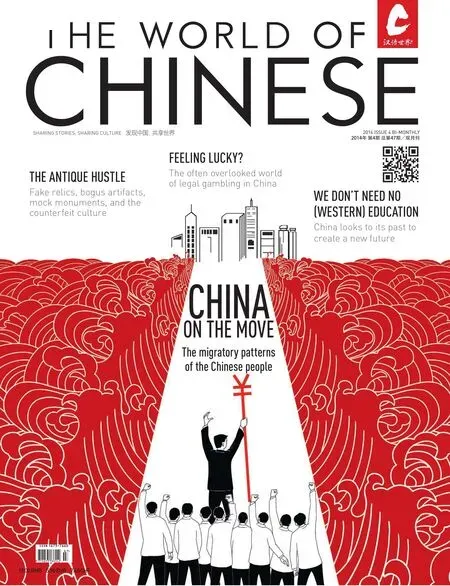WE DON’T NEED NO (WESTERN) EDUCATION
BY LIU JUE (劉玨)
WE DON’T NEED NO (WESTERN) EDUCATION
BY LIU JUE (劉玨)
Ancient Chinese answers to modern problems
五味雜陳的 “國學(xué)熱”
IN THE RECENT UPSURGE NO ONE SEEMS TO QUITE REMEMBER THAT, LESS THAN 50 YEARS AGO, CONFUCIAN CLASSICS AND TRADITIONAL ETIQUETTE WERE DESPISED BY THE CULTURAL REFORMISTS
In a time when China's best and brightest furiously scrabble to become world leaders in any available discipline, from IT and lasers right through to space exploration and robotics, there's one area where the nation lays clear claim to being ahead of the rest—Chinese National Studies, orguoxue(國學(xué)). Naturally, throwing off its competitors through def i nition alone, the subject exists as an oppositional force to “Western”disciplines and, more often than not, refers to any fi eld of scholarship that is traditional and native to China, be it Confucianism, Taoism, historical writings, ancient poems, medicine, or any number of the arts. In a sense we could call this study, Sinology. However, whereas Sinology has primarily been underpinned by the outsider looking in—the somewhat fetishized “Western” gaze, which Edward Said famously termed Orientalism—as far as Chinese National Studies goes, the fascination comes from within. “Anything that has withstood the test of centuries and has been passed down today, as long as it has a positive effect in our society, that can be calledguoxue—our unique traditional culture,” says Ji Jiezheng, a dignif i ed woman in her 50s wearing, quite fi ttingly, a dark greenqipaoand a pearl necklace.
Currently holding 100 students, mostly between four and six years of age, Director Ji's Chengxian Guoxue Institute is an example of the rejuvenation ofguoxuein recent years, its popularity spiking quickly as an academic discipline. Aff i liated with the respected Beijing Confucius Temple and Imperial College Museum (北京孔廟和國子監(jiān)博物館), the institute is proud of its work in enlightening the young through offering courses including introductory Confucianism, calligraphy, Chinese painting, and various traditional handcrafts for children.
Built in 14th Century China under the reign of emperor Chengzong of the Mongol Yuan Dynasty (1206-1368), the construction of the Beijing Confucius Temple was an attempt by the emperor to steady rule over his largely Han subjects. Located just inside the Second Ring Road, the temple has long been a place where emperors and scholars pay respect to the most inf l uential thinkers in Chinese history, and it has continued regardless of the capricious rise and fall of any number of dynasties. It still receives considerable worship even today: every morning, a group of small children—girls in pink and boys in bluehanfu(the traditional robes of the Han people)—line up and pay four respectful bows to a marble statue of Confucius, before starting their day at the institute.
In a world that's obsessed with piano, Olympic-level math and Disney-inspired English, it seems to many that traditional culture has emerged as a key element missing in a modern child's development. “The ideal life pattern of us Chinese is to fi rst cultivate the moral self, regulate one's family, then go on to attend state affairs, and fi nally bring world peace,” Ji says, quoting theGreat Learning(《大學(xué)》), a bona fi de Confucian classic, adding her own fl avor with: “No matter what career the kids pursue in the future, they fi rst have to learn how to be a moral person.”
“Chengxian” means “to become a virtuous person”, which is also part and parcel of Confucian beliefs.“As society developed, Chinese families shirked [their responsibility] and the human element seemed to diminish gradually. We no longer pay attention to manners and courtesy as before,” says Ji, who believes traditional etiquette helps form the bedrock of what it means to be a good person. As such, the institute putsDi Zi Gui(《弟子規(guī)》,Standards for Being a Good Pupil and Child) at the center of its teaching and philosophy.Di Zi Guiis merely a thousand-word long list of rules and suggestions written in the Qing Dynasty (1616-1911) by scholar Li Yuxiu, based on his teaching experience of Confucianism to young children. In it a good child is held up as a respectful, moral, and harmonious member of a family and community, as one excerpt goes: “Elder siblings should take care of the young, and the young should respect their elder siblings. The harmonious relationship among siblings will please the parents, thus fi lial piety is achieved. Don't take wealth too seriously, and you will be free from resentment; be tolerant in your words, and conf l ict will dissolve naturally.” To the institute,Di ZiGuiis not just a collection of practical advice, but answers a few of the ultimate philosophical questions. “It guides you to discover who you are and what you are supposed to do at your present stage of life,” says Ji.

Children recite Di Zi Gui and the Three-Character Primer at a primary school in Zhejiang Province

Primary and high school students celebrate the 2,562nd birthday of Confucius in Fujian Province
Enthusiastically, not relegated to privateguoxueinstitutes such as Chengxian, prestigious universities such as Tsinghua and Peking have also established research centers that fi rmly reside within a Confucian embrace. Wuhan University even goes so far as to offer a PhD degree inguoxue, which produced its very fi rst Doctor of Guoxue in 2012. In the recent upsurge no one seems to quite remember that, less than 50 years ago, Confucian classics and traditional etiquette were despised by the cultural reformists and were intensely vilif i ed as an outdated, corrupt, poisonous, and negative force, and, as a result, such teachings were hunted downand exterminated with careless abandon.
Modern wrangling aside,guoxuehas always occupied a special place in the hearts of Chinese intellectuals. During the 19th century, during the clash between China and the outside world, teachings from the West were labeled“new studies” while the original disciplines became known as “old studies”, orguoxue. Advocacy ofguoxue's continued ascendancy is ever-present, especially with the rise of the “Masters of National Studies” such as Zhang Taiyan (章太炎), Chen Yinke (陳寅恪), Qian Mu (錢穆), and most recently paleographer, linguist, and writer, Ji Xianlin (季羨林). The original academic def i nition ofguoxuewas much narrower than its popular understanding today. According to Zhang Taiyan's famed lectures onguoxuein 1922, the subject can be divided into three schools: the study ofjing(經(jīng)學(xué)), made up of the Confucian classics; the study of philosophy, which are schools of ancient Chinese philosophy outside Confucianism; and the study of ancient literature. Ji Xianlin, on the other hand, proposed the concept of a “broadguoxue” (大國學(xué)) in 2008, in which he includes all regional and ethnic culture into national studies, taking it beyond its earlier, more Han, conf i nes.
“HAN CULTURE DIED WITH THE MING DYNASTY, OUR FAITH DIED WITH THE CULTURAL REVOLUTION, AND OUR MORALITY DIED WITH THE ECONOMIC REFORM”
Perhaps inspired by the new concept or maybe simply misunderstood, as is so often the case when academics indulge in navel-gazing,guoxuehas become more and more open to a myriad of interpretations. In worse case scenarios, and often driven by prof i t, some merely use it as a name to garnish something completely different.
For non-academics,guoxue's popularity has boomed through various adult training programs that offer to change people's lives and better their careers—a sort of lowbrow self-help Confucianism that has proliferated in many aspects of society. Suchguoxueis promoted to CEOs and government off i cials at the highest level, as a must-know for their management and decision-making duties. Judging from its lofty ideals, such studies are certain to prove more useful than, say, a Stanford MBA. “To draw wisdom from national studies and reach a higher spiritual state” was stated as the core objective of one typical Peking Universityguoxuecourse, which cost 100,000 RMB per annum, covering the more predictable topics such as Confucianism, Buddhism, Taoism and Chinese history, but also the more unusual, such as an array of health tips drawn from Traditional Chinese Medicine. Suchguoxuenot only promises to benef i t the rich and powerful, but also to come to aid the ordinary people in their daily lives.
The 48-year-old former high-school Moral Cultivation teacher (yes, that's a real high school course), Li Yaojun is a busy public speaker booked by private companies and local governments alike, all year round. His topic of the day isDi Zi Gui, which he calls “people'sguoxue”. Boxes upon boxes ofDi Zi Guipamphlets, which he has meticulously revised, abound in his off i ce.“Organizations with goodwill fund the printing,” he says, adding, “when the leader of an organization learns the positive energyDi Zi Guican bring, they invite me to talk.” Among Li's audience are company employees, students, community residents, hospital staff, and, somewhat surprisingly, even prison inmates. Li fi rst used the teachings as educational material for his then 12-year-old daughter, but Li began to believe that such a moral education was equally in need amongst adults. Since then, Li has steadily worked his way up the ladder to become one of the leadingDi Zi Guievangelists.
“The teaching contributes to the happiness of the individuals and the harmony of society,” says Li. “There were times when we lost our culture: Han culture died with the Ming Dynasty, our faith died with the Cultural Revolution, and our morality died with the economic reform; such loss greatly damagedsociety and caused all kinds of problems—corruption, pollution, and food safety issues.” If Li is but a well-intentioned, somewhat naive, advocate of people fi nding morality within a traditional culture, there are cases of people taking it to greater extremes.
Someguoxueinstitutes have targeted women in an effort to transform them into better wives and mothers with the teaching of traditional “women's virtue” (女德). Journalist Ye Erniang recently went undercover to join aguoxuecamp named “Mengzheng Guoxue Institute”in Guangdong and discovered that not only was its teaching totally off the mark, but the entire camp had unnerving, cult-like characteristics. While the course was free and offered women the secrets to “enjoying a happy family life while having a successful career”, it also encouraged the donation of large sums of money in exchange for solving the female students' family troubles via further personal guidance. Asking women to dress plainly and to sit in an inferior position to their husbands at all times was one of theleastworrying aspects of the course; in what would, no doubt, have had many feminists turning in their graves (or perhaps sharpening their knives), it also encouraged women to never divorce or fi ght back when they receive verbal or physical abuse at home. “If women want to focus on their careers so much, why don't they just cut their uterus out and their breasts off to get rid of all their female characteristics?”Lectured one of the camp's teachers, adding, “Men and women have their own natural duties; follow your duties and you will fi nd the truth of the universe.” The course also claims that diseases can be cured naturally when patients achieve enlightenment. By the time the undercover journalist joined, the camp had already held over 100 sessions, and most of the students were returning ones, many bringing their family and friends with them. Theguoxueeducation market is crowded with many players, big and small, from the extremely unregulated to the downright scary, all seem to appeal to what is a very clear and present need.
Such a need can be further illustrated by the landscape of the current mass media. A TV program namedLecture Room(《百家講壇》, literally, The Hundred Schools of Thought Forum) has often been attributed to stimulating the public's interest inguoxue. Running for over a decade on CCTV-10, the science and education channel, the program aims to “l(fā)et experts and scholars serve the people” and build a bridge between academia and the masses.Lecture Roomis a hybrid TV lecture and documentary where experts, researchers, and university professors explain their area of expertise to the public. Originally it featured eminent physicists Stephen Hawking and Tsung-Dao Lee, writer Mary Poovey, artist Wu Guanzhong, and even Bill Gates; the program was poorly received until it switched its angle to exclusively featuring Chinese history, literature, and traditional culture. “‘What does this black hole have to do with me', the ordinary people would think,” saysLecture Room's former producer Nie Congcong. “It's just too far away from their life. Public demand is essentially why we changed the show.”
The program took off in 2004 via a series of lectures by historian Yan Chongnian on the emperors of the Qing Dynasty. Ever since, it has become a star factory for scholars. Yu Dan (于丹) onThe Analects of Confucius, Yi Zhongtian (易中天) presentingThe Romance of Three Kingdoms, and Liu Xinwu (劉心武) lecturing onThe Dream of Red Mansions—all became overnight scholar sensations, gaining attention approaching an academic version of pop idol stardom. “It's also the social environment,” says Nie. “For instance, Yu Dan's lecture onThe Analects of Confuciusin 2006 was just the kind ofChicken Soup for the Soulthe masses needed. Back then, they felt the benef i ts brought by the reform but also sensed pressure and insecurity. Society is heading to a new direction, prosperous at a glance, but people are overwhelmed by it and become restless. So, they look back to history and tradition to seek peace.” Almost 10 years have passed since the show peaked in popularity, but it cast a long-lasting shadow over the modern Chinese masses.
At present, Nie believes that things have changed a little, that the people took a look atguoxueand perhaps found it a little wanting. “The journey throughguoxueand traditional culture proved to be not quite successful. Right now, [what people want] is all about what's practical. ‘Having fun while it lasts' is the attitude. Look at the two most popular TV shows now: game shows and food or health; it's all practical. As to the future, it's a subject ordinary people don't care about.”
Guoxuecame into being through an encounter of China and the West, but it has taken on a wide range of meanings and is studied by anyone from serious academics and powerful CEO's right through to lonely housewives and confused students. To some, it's just a hip new buzzword that attracts people and then empties their pockets through any number of expensive courses; to others it brings a concrete sense of certainty mired in tradition, enabling them to calm their bewildered minds in a world of fast-paced social transformation; for a patriotic few it's a hope, a clinging onto, perhaps some semblance of a national identity in an ever-changing globalized world. China might have 5,000 years of history, but it could be thatguoxue, with its broad scope and contemporary paradoxes, turns out to be a roadmap to a unique Chinese modernity.

